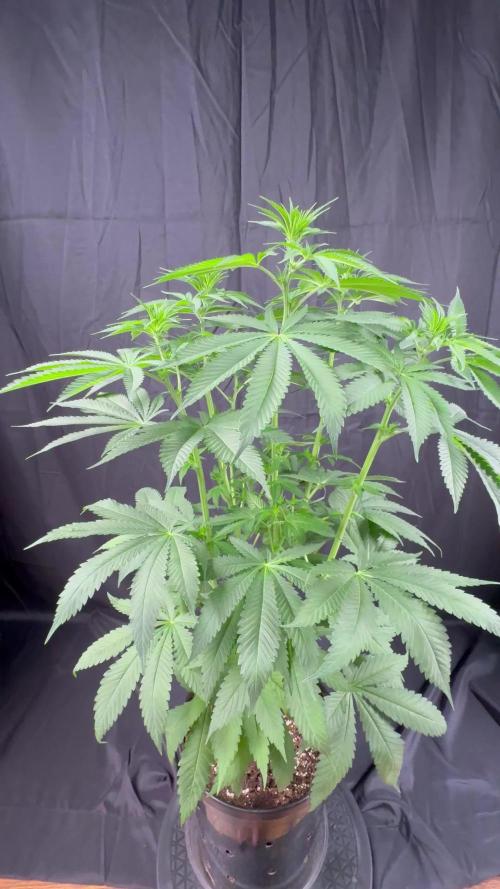The Grow Awards 2026 🏆 





































Likes
45
Share


@Natrona
Follow
Sour Jealousy Auto FastBuds 2025 Outside Grow
Week 3 April 20-26 Veg
This week was mostly sunny in the mid-eighties and low 60s at night with an occasional drop into the low 50s. I added kelp fertilizer to the water twice during the week. She is about 3 inches tall. I have had her under a dome for these past two weeks. This week, after heavy rain, I removed it for good since the leaves were touching the sides. Hopefully no renegade squirrels trample her.
Pics taken 4/21 & 24
Your likes and comments are appreciated. Thanks for stopping by.
Growers love 💚🌿
💫Natrona💫
Likes
72
Share


@BodyByVio
Follow
Day 37 from seed. 2nd day into week 6.
-My focus for this week is to keep room temperatures under 75 degrees since I notice that my roots don’t like high nutrients temp. And since I m in DWC single 5 gallons bucket I don’t have the possibility to chill the water. So I have to keep the room temp lower then I wish to.
- Day 41- I have to add nutrients and PH down every 12 hours. My PPM’s goes from 450 to 390 and my PH drift from 5.7 to 6.2 in less then 12 hours. Also I notice some rust on older levels (probably Ca/Mg deficiency). After some research (I’m new to this) I decided to up the nutrients to 600 PPM’s. Hopefully is a good decision.
I will really appreciate some feedback.
Likes
2
Share


@Ninjabuds
Follow
Gary Payton has had a slow start but it is starting to stack really nicely. I think it will probably be the longest stack plant out of all the ones I’m growing. The plant already has the distinct Gary Payton smell
All of the plants have really taken off. Usually I have a couple plants that are much smaller but all of these plants are getting huge. Seeing I got a new eluefah uap1500 the other day and I have my 2 fastbuds plants under that now I have my spider farmer light free. So I popped up another 2x2 and moved 3 of the 10 plants into the 2x2 and left the 7 other in the 2x4.
Likes
26
Share


@Beerus
Follow
Hello everybody, I think she responded well to the bending of the top, but i believe what she has might be nute burn so i ll cut on the nutrients this week and see what happens. Im starting to notice a slower groth, i hope i wont have to bend it no more . Also the bottom leaves droped , some naturally some with little help. Thanks again to all the people reading and supporting. Advice is always welcome!
Likes
3
Share


@Sp3cia1Ag3n7
Follow
Mary Jane the Sour Citrus by Sp3cialAg3n7 steals the spotlight at 8"! Lit up by dazzling LEDs, it's a thriving superstar. Perfect conditions, zero odors, and artistic shaping through LST and defoliation. Get ready for more green magic! #GrowDiary #SourCitrus #MaryJane
Likes
31
Share


@Mr_weed_pt
Follow
Week 7 it’s looking nice. Already flush let’s wait one more week or 2 and chop chop…
Likes
12
Share


@KannaGrowing
Follow
Semana de transición entre el abono para el periodo vegetativo (Bio Vega) y el abono que utilizaremos durante el periodo de floración (Bio Flores). El primero más rico en nitrógeno y el segundo, en fósforo, magnesio y potasio.
Mezclo Bio Rhizotonic + Bio Vega + Bio Flores y riego con 50 litros de agua, todo el cultivo... Alterno riegos cada tres días, unos con abono y otros con agua.
La próxima semana, elimináremos Bio Vega.
Likes
9
Share


@pzwags420
Follow
At the end of week 6 the buds are bulking up and the trichomes are going milky with red hairs pulling in will wait for more amber trichs before harvest which I anticipate around week 8-10.
Likes
103
Share


@CaliGrown
Follow
She was a gray big bush. Wish I could get her more dense but already popped 2 more of these beans bc it is one of my new fa new favorite strains.
Likes
18
Share


@birdmountain
Follow
Es wurde Zeit, das Wetter wurde ungemütlich, kalt und regnerisch. Die anderen Pflanzen hatten bereits Schimmel entwickelt und es war auch kein weiteres Blütenwachstum festzustellen. die Trichome sahen auch leicht angebräunt aus, Deshalb wurde geerntet und verarbeitet. Die Ernte der zweiten späten Pflanze war wesentlich geringer aber noch passabel.
Likes
8
Share


@Ieiogrow94
Follow
Eccoci di nuovo qui!!!
Super eccitato per questa nuova collab con Kannabia Seed Company, team davvero al top, che mi ha dato l’opportunità di testare questa nuova genetica e di condividere i progressi con tutti voi!!!
Ma che colori ha?!
Sono rimasto colpito da lei fin da subito e mi sono ritrovato tra le mani la migliore genetica del cultivo, seconda solo per sapore, odore e strato di resina devastanti, colori incredibili e una fattanza micidiale..
RESA ECCEZIONALE PER VASI DA 11L... SUPER CONSIGLIATA A TUTTI!!!
Davvero senza parole complimenti TEAM!!
Grazie a tutti per il supporto ❤️🍀🔥
Likes
29
Share


@eldruida_lamota
Follow
Esa familia, recta final de las green poison de sweet seeds, parece que quieren engordar así que habrá que alimentarlas bien con el PK.
Variedad con floración rápida, y con predominancia indica, veremos que tal acaban.
.
La humedad esta al 45% la temperatura está entre 21/28 grados , y como siempre el ph , ya que es de lo más importante,está en 5,8/6,0.
.
AgroBeta:
1 ml x L Flowering black line , vía radicular.
0,2 ml x L Beta shark, vía radicular.
0.5 gr x L mega PK , vía radicular.
0,8 ml x L Terminator, vía radicular.
0,5 gr x L Engordacogollos, vía radicular.
0,3 ml x L Tucán , vía radicular.
0,1 ml x L Betazyme, vía radicular.
0,3 ml x L Tricoma, vía radicular.
0,05 ml x L Gold Joker, vía radicular.
0,2 ml x L Silver, vía radicular.
.
Hasta aquí todo familia 🕸️ , un saludo y buenos humos fumetillas💨💨💨.
Likes
6
Share


@JeyGanesha
Follow
Prima settimana.inizio conta dei giorni..inizia a tirare fuori tutto il suo Power,🤣👍💪
Likes
11
Share


@Papastroumf
Follow
Day 42 : Watering with co2 tab / 5L. Also added food again because i think they need it. Increased ppm to 850. Maybe the next one will be pure water. Ventilation works all the time when lights are on. Temp and humi are stable and this is good for the girls. 6 cm in 3 days. Patience is the key always. Also removed some burned leaves from all ladies. She is beautiful community.
Edit (Day 46) : Watering with co2 tab every 5L. I watered with juices again at 850ppm because i felt that they need it. Only DsD drank pure water because of burns. She stopped height grow. Her buds are the most fat. She will be the first chop chop guys. :D :D :D . She is full of crystals.
Likes
10
Share


@Canadian_Steelheader
Follow
End of week 4 and all is going well, had a slight calcium issue on a couple of leaves, but it was corrected and all is good again. These girls are responding well to the nutes, but my run-off is getting a little high, that should change when I cut out the Flora Micro and just feed calmag, Dnectar and KoolBoom for the next couple of weeks. Any comments or suggestions? Wish me luck.... just a few weeks to harvest now.
Likes
27
Share


@I_Identify_As_A_Dan
Follow
Start of week 4 for Kalini Asia
Shes not doing too badly, not much too report on her.
Likes
59
Share


@Jsammy09
Follow
Officially two weeks since I planted the seed. These things have really grown since the flush and nutrients. Will be flushing and fresh water and nutes on Tuesdays. I will also add daily progress pics and updates.
7/1 (Day 14) - Everything is continuing to go pretty well. I feel pretty good and dialed in on my temps, humidity, and VPD. I've just been kinda monitoring everything and its going well. They seem to be doing ok. I definitely made the mistake of planting them two low in the net pots I think. Im not sure if that is going to hurt anything or not, they seem to be doing ok though. Ill try and get some pics of the roots, I felt under one of them to see if they had roots and there was one under that that was pretty damn gnarly and long already though. Will update later with pics if i can.
7/2 (Day 15)- Continuing to see good growth I think. Things continue to run well and everything is in check and staying the same. PH went up to 6.1 and I added a very small amount of PH down and waited about an hour an now we are back at 5.8.
7/3 (Day 16)- Everything continues as normal, got the new humidifier in and hooked up and its made life much easier. Plants continue to grow and seem to be happy. Tomorrow is flush day and new nutes! Ill try and get a video or something if I can remember.
7/4 (Day 17)- Flushed and refreshed everything. Its a long process due to waiting on the RO water. Everything is looking pretty good though. Just going to continue to monitor. Temp and humidity are still 78-79ish and around 65% RH during day and around 72-73 and 58-60%RH at night. PPM after this flush is around 650ppm or EC 0.9
7/5 (Day-18)- Every seems to continue to go pretty well. Temps, humidity, ph, and ec all stable, plants continue to grow!
7/6 (Day 19)- Pretty much same as yesterday, everything is staying steady and running pretty good, they are getting big but not really growing tall, wondering if it will shoot up soon or if i messed up by planting too deep in net pots.
7/7 (Day 20)- Had an issue this morning, woke up to some leaves curling down at the ends. Checked everything, temp 79, humidity 65%, water temp 68, EC is .9 so same as when I mixed, roots look great, 1 inch gap from net pot, airstins and everything is great. Came to conclusion my light was too close. I haven’t raised it and plants have grown a few inches. I think it was too close and burning. Moved the light to about 33 inches from top of plant now. Seem to be recovering slowly. Will monitor.
Any tips and recommendations always appreciated. Thanks.
Likes
1
Share


@Michijardinero
Follow
Bueno familia hoy damos fin a la 2° semana y damos comienzo a la 3° en esta semana han dado un estirón importante casi 25 cm la punta más alta esta entre 94-95 cm ya están empezando a mostrar sus cogollitos en el siguiente riego empezaré a ponerle big boom para darles más cuerpo e intentar sacar el máximo posible de momento estoy contento por como esta saliendo todo espero seguir así como siempre familia cualquier crítica comentario o Consejo bienvenidos son un abrazo y buenos humos familia paz
Likes
1
Share


@AtticGrow420
Follow
The Blappleberry Haze is producing more and more thick buds that are now taking on a beautiful purple color. The smell is still very, very fruity and the trichomes look like I could harvest the plant within the next 2 weeks. I will check the trichomes again before the next watering, if they are almost ready, I will only give it water and then no water for a week.


















